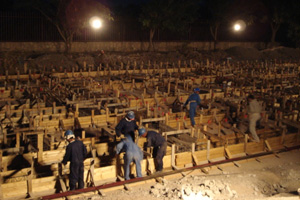
 |
|
The $21.4 million Anbar Judicial Complex contains holding cells, courtrooms, jury pools and adjudicants all within a single secure area in a multiple building complex. Photo courtesy of Multi-National Forces in Iraq/Master Sergeant Keith Milks. |
One high-profile example is the $21.4 million judicial complex renovation and construction effort recently completed in the Anbar provincial capital of Ramadi. The Anbar Judicial Complex is unique for two reasons: It contains holding cells, courtrooms, jury pools and adjudicants all within a single secure area in a multiple building complex, giving added protection to all parties and allaying fears associated with this process. This will significantly contribute to reducing terrorist influence and restoring order to the region. Also interesting is that it was built on the former Saddam Hussein family compound at the so-called "Hurricane Point" on the Euphrates River—once a stronghold for Saddam and sons Uday and Qusay.
The Almco Group of Companies, one of the largest firms involved in the Iraq reconstruction effort, hired FRA Engineering—which has previous Code Compliance experience in the Middle East—to provide design review services for the project. Phase I involved renovating two former palaces to create individual courthouses and support facilities. Phase II involved building a variety of housing and classroom structures for workers and detainees.
FRA was faced with some unusual challenges. One issue was security, because the area is still at risk for attacks, bombings and similar activities. The buildings required controlled access, which impeded egress. FRA discovered early on that the dormitory buildings, which house judges and other workers, were initially designed with transom lights in lieu of conventional windows. Lacking the water resources for sprinklers, FRA needed to redesign many of these for Emergency Escape and Rescue Openings.
Similarly, some of the materials and assemblies found in the former palace buildings converted into courthouse facilities were unlike conventional assemblies typically found throughout Europe and North America. These indigenous construction materials were not readily identified within the generally accepted reference standards found in the IBC. Developing appropriate fire-resistance ratings for these unique assemblies required a more extensive look at the elements and their basic construction techniques. In some cases, archaic material standards found within the International Existing Buildings Code Appendix provided a reference tool for evaluating the fire resistance and strength of the existing assemblies. Based on this Code Council data and FRA's experience, they were able to evaluate the existing structures.
Another challenge stemmed from the area's unreliable water supply, which precluded exclusive reliance on sprinkler systems that are typically required in assembly and dormitory occupancies. The final design relied heavily on the intrinsic fire resistance value of the indigenous building materials and the ability to compartmentalize the spaces within the buildings. The ability to utilize construction materials and techniques consistent with local traditions was more cost effective than importing materials and introducing new construction methods.
 |
|
Construction personnel working at night to complete the Anbar Judicial Complex. Photo courtesy of Almco Group of Companies. |
Through the ability to evaluate these modifications on an individual basis, the final design complied with the design goal of meeting the IBC and keeping project costs in line. The FRA review team provided suggested modifications to the plans that identified the multiple paths that are available for code compliance within the IBC. In this case, these were constrained by the limits of the water supply in the area, but the IBC Chapter 34 Compliance Evaluation permitted these unique buildings to be renovated in a safe manner without the often-utilized sprinkler systems found in this country while meeting their equally unique program needs.
In completing the Ramadi project, FRA credits the IBC with providing a variety of options for achieving code compliance. Their recent experience confirms that anyone with knowledge of the International family of codes can find compliance paths to overcome challenges in design, constructability and flexibility with a variety of materials, means and methods without compromising the safety of the occupants or of emergency responders.
James R. Burton is a senior plans examiner for infrastructure consulting firm FRA Engineering, where he manages its code compliance services group. During his 29-year career, he has overseen the design and/or construction of hundreds of residential, commercial and industrial buildings; has personally inspected more than 1,200 structures worldwide; and has testified as an expert witness is dozens of construction disputes and litigation cases involving the application of codes and standards. He also teaches Code Compliance Standards and inspection techniques to industry professionals.